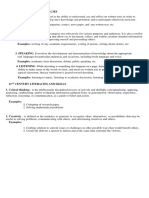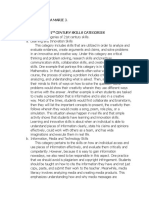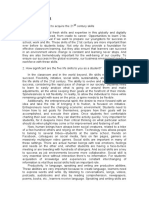0 ratings0% found this document useful (0 votes)
29 viewsThe 21st Century Learning
The 21st Century Learning
Uploaded by
Ma Sofia RoblesThe document discusses the skills needed for 21st century learners and teachers. It describes how learners today think differently and learn through technology and social platforms. It outlines key competencies like problem solving, critical thinking, and collaboration. It then discusses the "four C's" of 21st century skills - critical thinking, creativity, collaboration, and communication. It explains how each skill prepares students and how they work together to empower students. Finally, it describes the roles of a 21st century teacher as an adaptor who can modify lessons for different learners, a communicator who can teach anywhere through technology, and a lifelong learner themselves.
Copyright:
© All Rights Reserved
Available Formats
Download as DOCX, PDF, TXT or read online from Scribd
The 21st Century Learning
The 21st Century Learning
Uploaded by
Ma Sofia Robles0 ratings0% found this document useful (0 votes)
29 views62 pagesThe document discusses the skills needed for 21st century learners and teachers. It describes how learners today think differently and learn through technology and social platforms. It outlines key competencies like problem solving, critical thinking, and collaboration. It then discusses the "four C's" of 21st century skills - critical thinking, creativity, collaboration, and communication. It explains how each skill prepares students and how they work together to empower students. Finally, it describes the roles of a 21st century teacher as an adaptor who can modify lessons for different learners, a communicator who can teach anywhere through technology, and a lifelong learner themselves.
Original Title
The-21st-Century-Learning
Copyright
© © All Rights Reserved
Available Formats
DOCX, PDF, TXT or read online from Scribd
Share this document
Did you find this document useful?
Is this content inappropriate?
The document discusses the skills needed for 21st century learners and teachers. It describes how learners today think differently and learn through technology and social platforms. It outlines key competencies like problem solving, critical thinking, and collaboration. It then discusses the "four C's" of 21st century skills - critical thinking, creativity, collaboration, and communication. It explains how each skill prepares students and how they work together to empower students. Finally, it describes the roles of a 21st century teacher as an adaptor who can modify lessons for different learners, a communicator who can teach anywhere through technology, and a lifelong learner themselves.
Copyright:
© All Rights Reserved
Available Formats
Download as DOCX, PDF, TXT or read online from Scribd
Download as docx, pdf, or txt
0 ratings0% found this document useful (0 votes)
29 views62 pagesThe 21st Century Learning
The 21st Century Learning
Uploaded by
Ma Sofia RoblesThe document discusses the skills needed for 21st century learners and teachers. It describes how learners today think differently and learn through technology and social platforms. It outlines key competencies like problem solving, critical thinking, and collaboration. It then discusses the "four C's" of 21st century skills - critical thinking, creativity, collaboration, and communication. It explains how each skill prepares students and how they work together to empower students. Finally, it describes the roles of a 21st century teacher as an adaptor who can modify lessons for different learners, a communicator who can teach anywhere through technology, and a lifelong learner themselves.
Copyright:
© All Rights Reserved
Available Formats
Download as DOCX, PDF, TXT or read online from Scribd
Download as docx, pdf, or txt
You are on page 1of 62
Learners nowadays are different because
they think radically different from their
predecessors about and process knowledge.
The word "skills of the 21st century" is
commonly used to apply to such key
competencies, such as teamwork, digital learning,
analytical thinking, and problem- solving, which
proponents claim schools ought to teach to help
students succeed in the world today. Technology
in the 21st- century can be used as an incentive to
learn further information and not as a reason to
know less.
Students in the 21st-century learn in a
global classroom and not certainly within four
walls. They are more likely to find knowledge
by accessing the Web through mobile phones
and laptops or talking on a social networking
platform with friends. Likewise, several
teachers track and discuss assignments via
simulated classrooms.
1. Learning and innovation skills are what separate
students who are prepared for increasingly complex
life and work environments in today’s world and
those who are not. They include:
• Creativity and Innovation
• Critical Thinking and Problem Solving
• Communication
• Collaboration
The four C’s of 21st Century skills are some
of the most popular learning strategies in today’s
environment.
The four C’s are:
1. Critical thinking
2. Creativity
3. Collaboration
4. Communication
Critical thinking is all about
solving problems.
Creativity teaches students to think
outside the box.
Collaboration shows students how to
work together to achieve a common
goal.
Communication lets students learn
how to convey their ideas best.
1. Critical Thinking
It is the practice of solving problems, among other
qualities. In addition to working through problems, solving
puzzles, and similar activities, critical thinking also
includes an element of skepticism. This is important in the
21st Century because it’s harder than ever to verify
accurate information (mostly thanks to the Internet).
Critical thinking empowers students to discover the truth in
assertions, especially when it comes to separating fact from
opinion.
1. Critical Thinking
With critical thinking, students don’t just learn a set of
facts or figures. Instead, they learn how to discover the
facts and figures for themselves. They ask questions.
They become engaged in the world around them. They
help others think critically, too. That might be the most
important part of critical thinking. Once one student has
it mastered, it quickly spreads to their peers.
1. Critical Thinking
Whether they learn how to think critically from
spending time online or simply asking the “Why?” in
everyday life, this skill prepares students for a life of
independence and purposeful thought. Still, critical
thinking is just one of the four C’s in 21st Century
skills. It works just fine when students use it alone. But
when students combine it with the next skill, the sky's
the limit to what they can achieve.
2. Creativity
Creativity is the practice of thinking outside the
box. While creativity is often treated like a you-
have-it-or-you-don’t quality, students can learn
how to be creative by solving problems, creating
systems, or just trying something they haven’t tried
before. That doesn’t mean every student will
become an artist or a writer.
2. Creativity
Instead, it means they’ll be able to look at a
problem from multiple perspectives — including
those that others may not see. Creativity allows
students to embrace their inner strengths from
big-picture planning to meticulous organization.
As a student learns about their creativity, they
also learn how to express it in healthy and
productive ways.
2. Creativity
More importantly, they also become motivated to share
that creativity with others. Just like with critical thinking
that makes creativity contagious. One student creates an
interesting or innovative solution to a problem. Then, when
they share it, the next student can become inspired to try
something similar. That’s not to say every single creative
endeavor will be a ringing success. Students will fail at
some point, and some of their ideas simply won’t work.
2. Creativity
But that’s okay. The point of creativity is to encourage
students to think differently than convention demands.
They don’t have to do things the way they’ve always
been done. Instead, they can figure out a better way.
Students don’t have to embrace their creativity alone,
either. In fact, creativity works best when combined with
the next 21st Century skill.
3. Collaboration
Collaboration is the practice of working together to
achieve a common goal. It is important because whether
students realize it or not, they’ll probably work with other
people for the rest of their lives.
Virtually every job requires someone to work
with another person at some point, even if it’s for
something as simple as what to get for lunch. Practicing
collaboration helps students understand how to address a
problem, pitch solutions, and decide the best course of
action.
3. Collaboration
It’s also helpful for them to learn that other people
don’t always have the same ideas that they do. In fact, as
students practice collaboration more and more, they’ll learn
that they have almost none of the same ideas that others
do.
This can affect students in one of two ways.
First, it could discourage them since nobody seems to agree
with them that often. Second, it could embolden them
because they realize they’re bringing something unique to
every conversation.
3. Collaboration
As a teacher, it’s crucial that you encourage
students to look at themselves through that second lens.
That way, students learn that they should speak up when
they have an idea. They may not be on the money 100%
of the time — and some of their peers may have strong,
opinionated reactions
— but it’ll teach them to speak up when they’re working
with others.
4. Communication
Communication is the practice of conveying ideas
quickly and clearly. It is often taken for granted in today’s
society. After all, if you say something that means you convey
an idea.
In the age of text-based communications — SMS,
emails, social media, etc. — it’s never been more important
for students to learn how to convey their thoughts in a way
that others can understand them. That’s because text-based
communications lack tone, which is critical to understanding
the context of someone’s words.
4. Communication
Still, even in situations where vocal tone is
available, students need to learn how to communicate
effectively. That includes minimizing tangents, speaking
directly to an idea, and checking other participants to make
sure they’re engaged.
Reading an audience — even if it’s just two other
people in a group discussion — lets students determine
whether they should keep expanding on an idea or wrap up
their point. Their audience could even be their family at
thanksgiving dinner.
4. Communication
The point is that as students practice
communication, they become better at efficiently
conveying an idea without losing their point “in the
weeds,” so to speak. With communication locked down,
students can streamline their ideas and make a positive
impression on those around them. Still, it’s important to
note that communication isn’t enough on its own to help
students with 21st Century skills. To really succeed,
students need to use all four of these skills together.
The four C’s of 21st Century skills let students
create a whole that’s greater than the sum of its parts.
That may sound overly- generalized, and you may be
right. But the skills themselves are so general that it’s
difficult to pin down what, why, or how students should
learn the four C’s. It’s most accurate to say that students
need the four C’s for any and every reason.
Critical thinking teaches
students to question claims and
seek truth.
Creativity teaches students to
think in a way that’s unique to
them.
Collaboration teaches students that
groups can create something bigger
and better than you can on your own.
Communication teaches students how
to efficiently convey ideas.
Combined, the four C’s empower
students to become one-person think
tanks. Then, when those students get
together, they can achieve almost
anything!
The Adaptor
The 21st Century teacher is an adaptor. Harnessed as we are to an
assessment focused education model the 21st Century Educator must be able to
adapt the curriculum and the requirements to teach to the curriculum in
imaginative ways.
They must also be able to adapt software and hardware designed for a
business model into tools utilizable by a variety of age groups and abilities.
They must also be able to adapt to a dynamic teaching experience.
When it all goes wrong in the middle of a class, when the technologies fail, the
show must go on.
As an educator, we must understand and apply different learning styles. we must
be able to adapt our teaching style to be inclusive of different modes of learning.
The Communicator
“Anywhere, anytime” learning is a catchphrase we hear
often. Usually its paired with “life learner”. To have anywhere
anytime learning, the teacher to must be anywhere and anytime. It
does not have to be the same teacher, but the 21st Century teacher
is a communicator. They are fluent in tools and technologies that
enable communication and collaboration. They go beyond
learning just how to do it, they also know how to facilitate it,
stimulate and control it, moderate and manage it.
The Learner
We expect our students to be life long learners. How many schools
have the phrase “life long learners” in there mission statements and
objectives. We too must continue to absorb experiences and knowledge. We
must endeavour to stay current. I wonder how many people are still using
their lesson and unit plans from 5 years ago.
Information technology and certainly in many of the sciences,
especially the life sciences; knowledge, understanding and technology are
fluid and dynamic, they are evolving and changing.
To be a teacher here you must change and learn as the horizons and
landscape changes. The 21st Century teacher or educator must learn and
adapt.
The Visionary
Imagination, a key component of adaptability, is a crucial
component of the educator of today and tomorrow. They must see the
potential in the emerging tools and web technologies, grasp these and
manipulate them to serve their needs. If we look at the technologies we
currently see emerging, how many are developed for education?
The visionary teacher can look at others ideas and envisage how
they would use these in their class.The visionary also looks across the
disciplines and through the curricula. They can make links that reinforce and
value learning in other areas, and leverage other fields to reinforce their own
teaching and the learning of their students.
The Leader.
Whether they are a champion of the process of ICT
integration or the quiet technology coach, the ICT Trainer and a
teacher leading by example; A maverick or early adopter the 21st
Century Educator is a leader.
Leadership, like clear goals and objectives crucial to the
success or failure of any project.
The Model
We must model the behaviors that we expect from our students.
Today and tomorrow more so, there is an expectation that teachers will teach
values.
We, are often the most consistent part of our student life.
Teachers will see the students more often, for longer and more reliably than
their parents. This is not a criticism of the parents rather a reflection. The 21st
Century educator also models reflective practice, whether its the quiet, personal
inspection of their teaching and learning, or through reflective practice via
blogs, twitter and other medium, these educators look both inwards and
outwards.
These teachers also model a number of other characteristics.
These are not necessarily associated with ICT or the curriculum, but are of
equal importance.
The Collaborator
Ning, Blogger, Wikispaces, Bebo, MSN, MySpace, Second life -
as an educator we must be able to leverage these collaborative tools to
enhance and captivate our learners. We too, must be collaborators; sharing,
contributing, adapting and inventing.
Technology allows collaboration between teachers and students.
Creating digital resources, presentations, and projects together with other
educators and students will make classroom activities resemble the real
world. Collaboration should go beyond sharing documents via email or
creating PowerPoint presentations. Many great ideas never go beyond a
conversation or paper copy, which is a great loss. Collaboration globally can
change our entire experience.
The Risk taker
How can you as an educator know all these things? How can
you teach them how to use them… There are so many, so much to
learn. You must take risks and some times surrender yourself to the
students knowledge. Have a vision of what you want and what the
technology can achieve, identify the goals and facilitate the learning.
Use the strengths of the digital natives to understand and navigate
new products, have the students teach each other. The learning
pyramid shows that the highest retention of knowledge comes from
teaching others. Trust your students.
Thank you
for
Listening
You might also like
- Grade Nine Math Textbook OntarioDocument3 pagesGrade Nine Math Textbook OntarioSeanNo ratings yet
- C.S.Lewis - Meditation in A ToolshedDocument3 pagesC.S.Lewis - Meditation in A ToolshedValdis AbolsNo ratings yet
- How to Teach Kids Anything: Create Hungry Learners Who Can Remember, Synthesize, and Apply KnowledgeFrom EverandHow to Teach Kids Anything: Create Hungry Learners Who Can Remember, Synthesize, and Apply KnowledgeNo ratings yet
- 3A:Learning Skills Century Skill CategoriesDocument9 pages3A:Learning Skills Century Skill CategoriesMary Joy CorpuzNo ratings yet
- Mindfulness-A Teachers Guide PDFDocument13 pagesMindfulness-A Teachers Guide PDFtrancos1972100% (2)
- From Nonsense Syllables To Holding HandsDocument222 pagesFrom Nonsense Syllables To Holding HandsRodrigo MurguíaNo ratings yet
- The 4C's in EducationDocument5 pagesThe 4C's in EducationAbbie Ellaine GarciaNo ratings yet
- What Are The 4 C's of 21st Century Skills?Document9 pagesWhat Are The 4 C's of 21st Century Skills?Gierny Castañeda JulianNo ratings yet
- Four Cs of 21st Century LearningDocument11 pagesFour Cs of 21st Century LearningArnold C. LasitNo ratings yet
- The 4CDocument2 pagesThe 4CLiea CheongNo ratings yet
- The Four Pillars of Education Learning To KnowDocument12 pagesThe Four Pillars of Education Learning To KnowNoemie Anne Ebitner IgnacioNo ratings yet
- Critical Thinking:-: Good Afternoon Friends!Document2 pagesCritical Thinking:-: Good Afternoon Friends!SHASHWAT SURI class 9-DNo ratings yet
- 21st Century Education ModelDocument16 pages21st Century Education ModelKhimz YadacNo ratings yet
- Creative Learning, Creative Teaching: What Is Creativity?Document4 pagesCreative Learning, Creative Teaching: What Is Creativity?Sharanu HolalNo ratings yet
- Implementation 4 Cs in ClassroomDocument10 pagesImplementation 4 Cs in ClassroomRita SavitriNo ratings yet
- 5010-Assisgment-Unit 7Document8 pages5010-Assisgment-Unit 7Nguyễn Thị Thùy LinhNo ratings yet
- Reflection: "21 Century Literacy Skills and Teaching Resources"Document4 pagesReflection: "21 Century Literacy Skills and Teaching Resources"Berryl MayNo ratings yet
- Learning SkillsDocument23 pagesLearning SkillsDr. J. Josephine JACNo ratings yet
- JMjYcNZq1WgI1Uv6ZkHGxm16hAElBWnlgpjmqKpt (2)Document12 pagesJMjYcNZq1WgI1Uv6ZkHGxm16hAElBWnlgpjmqKpt (2)Shukurova DilfuzaNo ratings yet
- Principles For 21st Century Learning SkillsDocument4 pagesPrinciples For 21st Century Learning SkillsRickver DiezNo ratings yet
- 21st Century Learning To ImplementationDocument15 pages21st Century Learning To Implementationhero zamruddynNo ratings yet
- TTL-21ST CenturyDocument8 pagesTTL-21ST CenturyYasmin G. BaoitNo ratings yet
- Principles of Teaching 2Document7 pagesPrinciples of Teaching 2Harlene DraguinNo ratings yet
- Ucu 100 Assignment 1Document4 pagesUcu 100 Assignment 1OGEGA KERUBONo ratings yet
- Learner-Centered Classroom and Personalized InstructionsDocument3 pagesLearner-Centered Classroom and Personalized InstructionsAlona Patata LaporteNo ratings yet
- SED 3205 - Fundamental of 21st Century LiteraciesDocument11 pagesSED 3205 - Fundamental of 21st Century Literacieshashirama0801No ratings yet
- Villadolid, Thea Marie J - 1st CENTURY SKILLS CATEGORIESDocument4 pagesVilladolid, Thea Marie J - 1st CENTURY SKILLS CATEGORIESThea Marie Villadolid100% (1)
- Complex Problem SolvingDocument6 pagesComplex Problem SolvingannieNo ratings yet
- Collaborative (Group 4)Document22 pagesCollaborative (Group 4)rosellarelos01No ratings yet
- Kurnia Saputri - EFL - Mid - TestDocument13 pagesKurnia Saputri - EFL - Mid - TestkurniaNo ratings yet
- Teaching Is Not Only A Job But Is A Way of LifeDocument22 pagesTeaching Is Not Only A Job But Is A Way of LifeSahil NaikNo ratings yet
- Technology For Teaching and LearningDocument7 pagesTechnology For Teaching and LearningJanelle Mikaela100% (1)
- Lesson 3 How To Teach 21st Century SkillsDocument53 pagesLesson 3 How To Teach 21st Century SkillsNard Kindipan GumarangNo ratings yet
- chapter 3Document4 pageschapter 3danoduori87No ratings yet
- 504 Deissler-Final Synthesis PaperDocument11 pages504 Deissler-Final Synthesis PapermrdeisslerNo ratings yet
- Differences Between Teaching ApproachDocument9 pagesDifferences Between Teaching ApproachRizza Janne UgalinoNo ratings yet
- Cruz, Christian Jhace M. Salcedo, Angela Caparas, Carla Bsed 1A Sir Mariano de JesusDocument5 pagesCruz, Christian Jhace M. Salcedo, Angela Caparas, Carla Bsed 1A Sir Mariano de JesusJhace CruzNo ratings yet
- Characteristics of Teachers and Students Are in The 21st CenturyDocument3 pagesCharacteristics of Teachers and Students Are in The 21st CenturyA SetiyardiNo ratings yet
- Critical Thinking Edf 111Document5 pagesCritical Thinking Edf 111ulumaomar2004No ratings yet
- 21st Century SkillsDocument7 pages21st Century Skillsjayrald baraoidanNo ratings yet
- Lesson 7Document4 pagesLesson 7api-534445995No ratings yet
- ASSIGNMENT NO 5 Educ 108Document3 pagesASSIGNMENT NO 5 Educ 108Earl Denuna AresNo ratings yet
- Teaching StrategiesDocument11 pagesTeaching StrategiesArnold CimzNo ratings yet
- Pa PprintDocument2 pagesPa Pprintrosalie.luarezNo ratings yet
- 21st CENTURYDocument6 pages21st CENTURYcarwilla may canuaNo ratings yet
- Case StudyDocument4 pagesCase StudySakthi Vel100% (4)
- Design Thinking in EducationDocument11 pagesDesign Thinking in EducationGuyan Gordon100% (1)
- Romi PDFDocument3 pagesRomi PDFPatricia Solomon CapiliNo ratings yet
- Learning To Live TogetherDocument21 pagesLearning To Live TogetherCeej Bahian Sacabin100% (1)
- Journal 3Document2 pagesJournal 3api-528763821No ratings yet
- My Self Reflection Checklist As A TeacherDocument6 pagesMy Self Reflection Checklist As A TeachersweetienasexypaNo ratings yet
- 21st Century 2Document10 pages21st Century 2Nona Siti RukmanaNo ratings yet
- Innovative Method of TeachingDocument8 pagesInnovative Method of Teachingapi-264649244No ratings yet
- Learning Revolution ReflectionsDocument6 pagesLearning Revolution ReflectionsJONLOU DALIDANo ratings yet
- EDUC 307 NotesDocument24 pagesEDUC 307 NotesjulianfvallsNo ratings yet
- Sample AnswersDocument9 pagesSample AnswersJane Uranza CadagueNo ratings yet
- LEARNING STYLESDocument4 pagesLEARNING STYLES2chandlershad23No ratings yet
- Lesson III TtliiDocument29 pagesLesson III Ttliiنجشو گحوشNo ratings yet
- MODULE 5 Building and Enhancing New Literacies Across The CurriculumDocument13 pagesMODULE 5 Building and Enhancing New Literacies Across The CurriculumLance Austria100% (1)
- Edu 693 Portfolio Project - Sectiom 6 Video Script FinalDocument7 pagesEdu 693 Portfolio Project - Sectiom 6 Video Script Finalapi-418323991No ratings yet
- 21st Century EducationDocument7 pages21st Century EducationKaye Eloiza Del CastilloNo ratings yet
- HRG 8 Module 10Document28 pagesHRG 8 Module 10Sophia Mari P. SuladayNo ratings yet
- Edutopia Parents Guide 21st Century LearningDocument10 pagesEdutopia Parents Guide 21st Century LearningAma FrempsNo ratings yet
- Marketing Design Thinking EnglishDocument17 pagesMarketing Design Thinking Englishzamans98No ratings yet
- Hodson-Sensechapter Citado Pela SasseronDocument253 pagesHodson-Sensechapter Citado Pela SasseronDaniel Sucha HeidemannNo ratings yet
- Redbull PassportDocument1 pageRedbull PassportAnonymous uLAUy6No ratings yet
- Critical Thinking in Technology StudentsDocument6 pagesCritical Thinking in Technology StudentsSolomon AhimbisibweNo ratings yet
- SyllabusDocument5 pagesSyllabusRohit RockyNo ratings yet
- Zodiac Academy: MSC Entrance Examination Advanced Subject: Nursing Education Mr. Arun Mangattu. MSC NDocument151 pagesZodiac Academy: MSC Entrance Examination Advanced Subject: Nursing Education Mr. Arun Mangattu. MSC NArun KumarNo ratings yet
- Full Download Fundamentals of Curriculum Passion and Professionalism 2nd Edition Decker F. Walker PDFDocument84 pagesFull Download Fundamentals of Curriculum Passion and Professionalism 2nd Edition Decker F. Walker PDFradulyakaloo100% (18)
- LS 3 Mathematical and Problem Solving SkillsDocument60 pagesLS 3 Mathematical and Problem Solving SkillsEvan Maagad LutchaNo ratings yet
- Meditations by Marcus Aurelius - The Rabbit HoleDocument8 pagesMeditations by Marcus Aurelius - The Rabbit HoleSahil SharmaNo ratings yet
- Module 2 - Critical Thinking and ReadingDocument20 pagesModule 2 - Critical Thinking and Reading19010031No ratings yet
- PPRTDocument18 pagesPPRTandrew gauranaNo ratings yet
- Be Unit 5Document20 pagesBe Unit 5amol0134No ratings yet
- 4 ThesisDocument209 pages4 ThesisLawrence NgeneNo ratings yet
- The Nature of Horror - Noel CarrolDocument10 pagesThe Nature of Horror - Noel CarrolAdam EtinsonNo ratings yet
- Principles of TeachingDocument15 pagesPrinciples of TeachingSean HooeksNo ratings yet
- While I'm Shuffling: N°1 - CreateDocument24 pagesWhile I'm Shuffling: N°1 - CreateJoe Wang100% (1)
- Business Seminar Notes-2021-1Document41 pagesBusiness Seminar Notes-2021-1Meshack MateNo ratings yet
- Dalai LamDocument48 pagesDalai LamCamila Gonzalez SepulvedaNo ratings yet
- WVES222PVMEC2022Document14 pagesWVES222PVMEC2022ilanaskapieNo ratings yet
- DecompositionDocument11 pagesDecompositionatuwootindoNo ratings yet
- Agarbatti Maker - HCS - Q7901 - v2.0Document52 pagesAgarbatti Maker - HCS - Q7901 - v2.0maheshNo ratings yet
- Class 2Document5 pagesClass 2Georgina FelipeNo ratings yet
- BBA Syllabus 1st, 2nd, 3rd & 4th SemDocument46 pagesBBA Syllabus 1st, 2nd, 3rd & 4th SemSamiksha Castle50% (2)
- Engaged E BOOK 365 Connecting Questions 1 - 19 7nkw5eDocument211 pagesEngaged E BOOK 365 Connecting Questions 1 - 19 7nkw5eSophie ScottNo ratings yet
- Month 1 Webinar Richard SchwartzDocument20 pagesMonth 1 Webinar Richard SchwartzMaria PopoviciNo ratings yet
- Career Guidance Answers OnlyDocument17 pagesCareer Guidance Answers OnlyWilbert BeringNo ratings yet

























































































